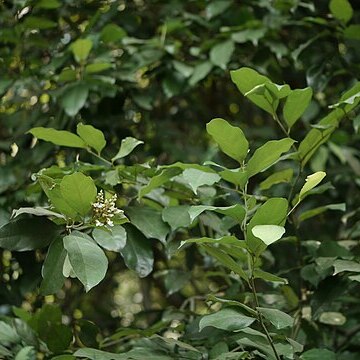Trees 5-25(-32) m tall; trunk 15-35 cm d.b.h.; bark gray, cork thick. Branchlets slender, yellow tomentose, angular. Petiole deep yellow-brown, ca. 1 cm, adaxially sulcate; leaf blade greenish, shiny, lanceolate or oblong-lanceolate, 10-24 × 2.5-6.5 cm, leathery, both surfaces glabrous, midvein raised abaxially, evident adaxially, lateral veins 6-8 pairs, raised abaxially, distinct adaxially, anastomosing near margin, veinlets reticulate, base cuneate, margin sometimes undulate, apex acuminate (tip to 1.5 cm). Racemes or panicles terminal or axillary, usually much branched, to 15 cm; terminal branchlets equaling lateral ones, densely yellow tomentose; peduncles usually compressed, ca. 9 mm; pedicels ca. 6 mm; bracteoles triangular-subulate, ca. 1 mm, densely yellow tomentose. Flowers usually subopposite and pseudowhorled. Sepals: outer 2 ovate or elliptic-ovate, ca. 2.5 × 1.8-2.3 mm, both surfaces tomentose, apex acuminate; inner 3 obovate-elliptic or elliptic, ca. 3.5 × 2.3 mm, both surfaces pubescent, ciliate. Petals white, 6-7 mm, keel abaxially pilose. Stamens 8, 5-7 mm; filaments shortly adherent at base of petals, inflated, villous; anthers sagittate-ovoid, ca. 0.8 mm, slightly furcate at base. Disk annular, 1.5-2 mm in diam. Ovary subglobose, ca. 1.5 mm in diam., with stalk ca. 1 mm, plump, smooth; style ca. 6 mm, villous; stigma slightly lobed. Drupe green when young, ca. 1.8 cm in diam., glabrous; fruit stalk 0.5-1 mm. Seed not seen. Fl. Mar-Apr, fr. May-Jul.
A tree. It grows to 36 m high. The trunk is 100 cm across. The leaves are oblong. They taper to the tip. They are 7-26 cm long by 3-11 cm wide. There are 6-10 pairs of secondary veins. The flowers are yellow or white. The fruit is round and green. It is 2 cm across.

